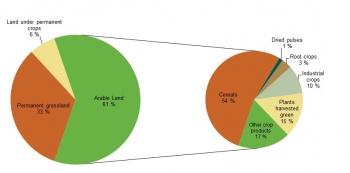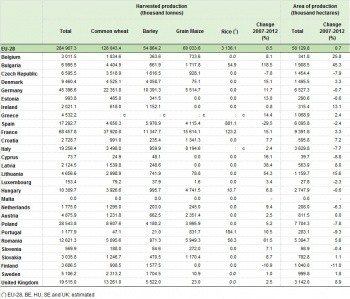Archive:Main annual crop statistics
- Data from July 2013.
Main agricultural crops: potato production 2012 almost 15 % below that of 2007, oilseeds production boosted by biofuels demand
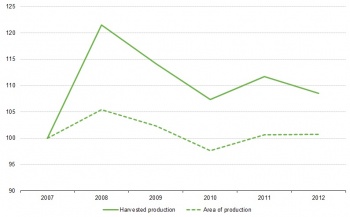
Source: Eurostat (apro_cpp_crop)

Source: Eurostat (apro_cpp_crop)

Source: Eurostat (apro_cpp_crop)
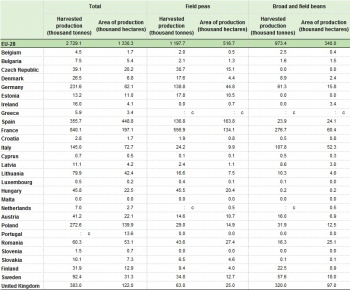
Source: Eurostat (apro_cpp_crop)
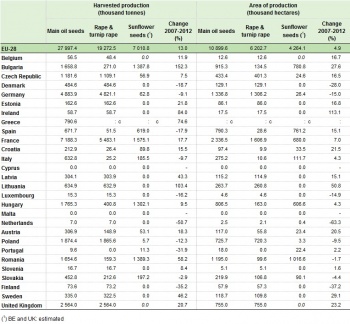
Source: Eurostat (apro_cpp_crop)

Source: Eurostat (apro_cpp_crop)

Source: Eurostat (apro_cpp_crop)
Main statistical findings
In the EU-28 there was an increase in the volume of cereals (+8.5 %), green maize (+23 %) and oilseeds (+13 %) between 2007 and 2012. On the contrary, potatoes (-14.2 %) and sugar beet (-0.4%) showed a decrease during the same period.
France and Germany were by far the largest cereal, sugar beet and oilseed producers in 2012, together accounting for more than half of the EU-28’s sugar beet (53.2 %) and oilseeds production (54 %) and 42% of its cereal production in 2012. The production of potatoes was more widely spread across the EU Member States, with Germany recording the highest production volume (almost 20% of the EU-28 total), while Poland, France and the Netherlands each accounted for between 17 % and 12 %. France was, by a large margin, also the leading producer of pulses and responsible for nearly one third (31 %) of the total EU-28 production.
Cereals dominate the total EU arable area
The EU-28 total utilised agricultural area (UAA) covered nearly 178 million hectares in 2011. While the biggest part (61 %) consisted of arable land, nearly one third was occupied by permanent grassland, and only 6 % by permanent crops.
The main crops grown on the total of 107 million hectares of arable land available in the EU-28 in 2011 were cereals (including rice), occupying sligthly more than 57 million hectares. This equates to more than half of the total arable land or nearly one third of the total UAA (32 %). Together with, plants harvested green (15 %), industrial crops (10 %) and “other crop products” (17 %) they covered 96 % of the total arable land. The remaining 4 % was dedicated to the growing of root crops (3 %) and dried pulses (1 %).
In two Member States, almost the entire utilised agricultural area in 2011 was taken by arable land: in Finland it was 98 % and in Denmark it amounted to 92 %. Conversely, the proportion of arable land in the total utilised agricultural area was below 50 % in six Member States: Lithuania, (48 %), Luxembourg (47 %), Slovenia (37 %), the United Kingdom (35 %), Portugal (30 %) and Ireland (23 %). These countries also had the highest share (over 50 % of the total UAA) of permanent grassland, likely explained by the high numbers of grazing animals. The largest area of grassland was reported in Ireland (77 % of the total UAA). Regarding the proportion used for permanent crops, only two countries reported a share higher than 20% of the total UAA: Portugal (36 %) and Cyprus (24 %). These high proportions are likely linked to suitable climatic conditions for growing permanent crops such as olive trees, vineyards and other fruit trees.
2012: three Member States cover half of the EU-28 production of cereals
Production of cereals in 2012: three Member States together account for half of the EU-28 production
Occupying more than 58 million hectares, cereals are the main crops grown in the EU-28. In 2012, the harvested cereal production amounted to nearly 285 million tonnes, of which 128 million tonnes represented common wheat. This makes wheat by far the most important cereal grown (45 % of EU-28 cereal production). The second largest harvested quantity was maize (60 million tonnes or 21 % of total cereal production), followed closely by barley (55 million tonnes or 19 % of total cereal production). The production of other cereals (consisting of triticale, rye, oats and spelt) had a cumulated share of 14 % and only around 1 % of the total EU production consisted of rice(corresponding to a volume of around 3 million tonnes).
Cereal production is concentrated in a few Member States with just three Member States making up half of the total EU-28 production: France (24%), Germany (16%) and Poland (10%). Unsurprisingly, France and Germany were also the biggest producers of wheat and barley. Together they accounted for nearly half (47%) of the total EU-28 wheat production and 40% of the total barley production. Other main producers of barley include Spain (11%) and the United Kingdom (10%). France is also the largest grain maize producer, accounting for 26% of total maize production in the EU-28. Together with Italy (nearly 14%) and Romania (10%) these three Member States covered half of the total EU-28 grain maize production in 2012.
Growing conditions and climatic prerequisites are such that only eight countries produced rice in the European Union in 2012; Half of the total EU production was reported by Italy, followed by Spain with 28 %.
2002-2007: no change in EU harvested area, slight increase of cereals production
Since 2007, cereal production has fluctuated considerably. Due to comparatively high cereal prices in 2007 caused by unbalanced supply and demand, EU farmers have reacted with a significant production increase (by 21.5 % compared to the previous year). However, unfavourable climatic conditions have led to a production decrease in 2009 (by approximately 6 % compared to 2008). The downward trend continued in 2010 and production decreased again by further 6 % compared to 2009. Although in 2011 cereal production increased slightly (up 4 % compared to 2010), a 3 % drop was again registered in 2012. Despite these occasional production decreases (2008, 2009 and 2012), the total level of cereal production within the EU-28 stood nevertheless 8.5 % higher in 2012 than in 2007.
Unlike the production, the harvested area of cereals in the EU-28 has remained relatively stable between 2007 and 2012 – never fluctuating by more than 6 %. In 2012 the area was only slightly higher than in 2011 (less than one percent).
Root crops: Germany and France together account for half of the EU-28 sugar beet production
The largest area (1.8 million hectares) was occupied by potatoes, just closely followed by sugar beet (1.7 million hectares). Other root crops not classified elsewhere (e.g. fodder beet, fodder kale, rutabaga, fodder carrot, turnips, etc.) were of lesser importance. Thus, this section concentrates on potatoes and sugar beet only and offers an overview of selected statistics and indicators linked to their production in the EU-28.
With nearly 116 million tonnes of sugar beet harvested from about 1.7 million hectares in 2012, the EU is the world’s leading producer. The northern part of Europe has the most suitable climate for growing beet and consequently, the largest areas are found in Germany and France, each with around 0.4 million hectares (equating to 24% each of the EU-28 total). A higher yield per hectare made France the biggest single producer in the EU in 2012. France and Germany together were responsible for more than half of the EU-28 sugar beet production (France with 29% and Germany with 24% of the total EU-28 production). The other important sugar beet producers in 2012 were Poland (11% of the total EU-28 production) and the United Kingdom (7.3%). The four countries together covered 71% of the EU-28 production in 2012.
Compared to sugar beet, potato production was better spread across the EU Member States. Still, Germany, which reported the highest level of production (almost 20% of the EU-28 total in 2012), and Poland (16.5%) were jointly responsible for more than one-third of the EU-28 total production. Together with three other Member States, the Netherlands (12.3%), France (11.5%) and the United Kingdom (9.5%) were responsible for nearly 70% of the total EU-28 potato production. Poland had the largest harvested area in 2012 with nearly 0.4 million hectares (one fifth of the EU-28 total potatoes area), followed by Germany and Romania each harvesting around 0.2 million hectares. These three countries thus covered nearly half of the EU-28 total area of potato production.
Taking into account the EU-28 average yield per hectare (30.3 tonnes), the share of Romania’s production accounted for only 4.5 % of the total EU-28 production due to the very low yield (around 10 tonnes per hectare).
2007-2012: Disappearance of sugar beet in several Member States
Given the fixed production quotas and the increasing yields in the EU-28, sugar beet area has reduced by almost 9% between 2007 and 2012, while the production decreased by just 0.4%. However there were large fluctuations in sugar beet production due to the CMO 2006 reform, followed by the restructuring of the sugar beet sector and partially also due to favourable weather conditions during the harvesting year 2010/2011.
The situation differs considerably in the individual Member States. In some Member States sugar beet production has completely disappeared (Ireland, Bulgaria, Slovenia, Portugal and Latvia), while in others there have been significant production declines (Italy -46%, Spain -30%, Greece -62%, Hungary -55%, Croatia -42%, Finland -41%). Finally, there are Member States where the sugar beet production volumes have not fallen so much, and in some cases increased. These are the Member States of the so-called “beet belt”, with most suitable pedo-climatic conditions for sugar beet growing: France (+2%), Germany (+10%), the United Kingdom (+25%), the Netherlands (+4%), the Czech Republic (+34%), Austria (+17%), Denmark (+18%), Sweden (+2%), Lithuania (+25%) and Slovakia (+6%).
Both potato production and its associated area declined between 2007 and 2012, although the area declined more sharply. Despite some fluctuations, the total harvested area dropped by 0.4 million hectares (or 18%) between 2007 and 2012. In the same time span, production fell by 9 million tonnes (-14%). The situation differs considerably between countries, ranking from small increases in three Member States only (Luxembourg by 3.1%, Denmark and Sweden by 2.4% each) to considerable reductions in Latvia (-62%), Bulgaria (-49%) and Croatia (-49%). Still, these impressive decreases have had only a very small impact as these countries have little weight in total EU production (less than 1% in 2012). Responsible for the decline at the level of the EU-28 were the bigger producer countries, such as Poland (2.7 million tonnes less than in 2007), Romania (-1.2 million tonnes) and Germany (-1.0 million tonnes).
Dried pulses
Production of dried pulses: France biggest EU producer
Dried pulses are crops sown and harvested mainly for their protein content and include in particular field peas, broad and field beans, sweet lupins as well as other dried pulses such as dried beans, chick peas, lentils, vetches, etc.
In the EU, dried pulses were grown on 1.3 million hectares (1.2 % of the total arable land) and their production reached 2.7 million tonnes in 2012. The harvested production of field peas (1.2 million tonnes) and broad and field beans (1 million tonnes) alone accounted for 80 % of the total EU-28 production of dried pulses. Production and area differ considerably between Member States.
As regards production, France is the biggest dried pulses producer (30.8 % of the total EU-28). French production of field peas accounted in 2012 for nearly half (46.5 %) of the total EU-28 field peas production, followed by Spain (11.4 %) and Germany (11.6 %), while the United Kingdom occupied in 2012 the leading position in the production of broad and field beans accounting for one third of the EU-28 total, followed by France (28.4 %) and Italy (11.1 %).
As concerns harvested areas, Spain alone featured more than one third of the total EU dried pulses area (close to 0.49 million out of a total of 1.33 million hectares) in 2012. However, due to a yield under 1 tonne per hectare, its production was less than half of that recorded in France which harvested area was more than half of Spain’s .
Oilseeds
Oilseeds: a quarter of the total 2012 EU production in France alone
Oilseeds such as rape and turnip rape, sunflower seed, soybeans, linseed and other oilseeds were grown on nearly 11 million hectares across the EU Member States in 2012 (10.2 % of the total arable land). Oilseeds are essentially used to provide vegetable oil that is used in the food industry and to produce biodiesel, apart from being used as an important protein-rich animal feed ingredient. The production of vegetable oils in the EU has been encouraged in regard to the mandatory use of biofuels in the EU by 2020. As a result, EU oilseed production has grown considerably in recent years.
Oilseed production in the EU-28 reached nearly 28 million tonnes in 2012. France was by far the largest oilseed producer and accounted for more than one quarter of the EU total and more than 21 % of the total EU oilseed harvested area. Together with two other Member States (Germany with a share of 17.4 % and the United Kingdom with 9.2 %), more than half of the total EU oilseed production in 2012 was reached. Rape, turnip rape and sunflower seeds were the major oilseed crops grown in the EU; considered together, these accounted for 94 % of the total EU-28 oilseed production and covered 96 % of the total EU oilseed area in 2012.
Concerning rape and turnip rape, out of a total of 19 million tonnes harvested in 2012 (69 % of the total oil seed production), France was the largest producer by a large margin with nearly 29 % of the total production. Other important producers were Germany (25 % share), the United Kingdom (13 %) and Poland (10 %).
Sunflower seed production is concentrated in Eastern Europe: although France is the largest producer (23 %), Romania, Bulgaria (each with 20 %) and Hungary (19 %) account for substantial shares in the EU total. Together these four Member States accounted for four fifths of the EU-28 sunflower seed production and covered nearly three quarters of the total EU-28 sunflower seed area in 2012. Large areas of sunflower production were also reported in Spain (nearly 0.8 million hectares or 18 % of the total EU sunflower seed area), but climatic conditions are such that lower yields have to be accepted as Spanish sunflower seed production amounted to only 9 % of the total EU-28 production.
Harvested production of oilseeds versus production area: decline of 7% in production of oilseed crops between 2009 and 2012
Oil seed crops production followed an upward trend up to 2009 (+ 22 % between 2007 and 2009), but decreased slightly in the following year, standing at a total production of 29 million tonnes in 2010. After a modest increase in 2011 (by around 1.3 %), the EU harvests of oilseed crops decreased by 6 % again to a total of 28 million tonnes in 2012. This drop may be attributed to reduced sowings and lower yields due to unfavourable weather conditions (winter kill and drought) occurring in the major production regions.
Green maize
Plants harvested green: three Member States responsible for more than 90% of the increase of green maize production between 2007 and 2012
Plants harvested green (annual plants, including green maize, leguminous plants and temporary grasses and grazing) were grown on 16 million hectares in the EU in 2012 which corresponded to 15.0 % of total arable area. Within the category of “Plants harvested green”, green maize is by far the most important crop. Therefore, this paragraph concentrates on green maize only and aims to give an overview of the selected statistics and indicators linked to its production in the EU-28.
Green maize was harvested from nearly 6 million hectares in the EU-28 in 2012. The area increased by 0.9 million hectares (or 17 %) compared to 2007. Its production amounted to 213 million tonnes, nearly 40 million tonnes more compared with 2007 (+23 %). The production increased more than the area, suggesting a higher yield. Natural conditions and both production and consumption behaviour result in heterogeneous production patterns across the individual Member States.
With nearly 95 million tonnes of production harvested from about 2 million hectares in 2012, Germany is the EU-28’s leading producer of green maize. Germany and four other Member States, Poland (12 %), France (9 %), Italy (7 %) and the Netherlands (5 %), together were responsible for more than three quarters (78 %) of the total EU-28 green maize production. Moreover, the same countries accounted for 77 % of the total EU-28 green maize area. Between 2007 and 2012, significant increases in the three Baltic countries were observed (Latvia +422 %, Estonia +312 % and Lithuania +228 %) contrasting sharply with a complete termination of production in Cyprus. Although these countries had only a very small impact due to their small share in total EU production (less than 1 % in 2012), the main factors for the upward trend can be found in the most important producer countries: Germany produced 26 million tonnes more, or 37 %), Poland (8 million tonnes more, equivalent to a plus of 45 %) and the Czech republic (plus 3 million tonnes, a 50 % increase). These three Member States together were responsible for 91 % of the increase of green maize production (40 million tonnes) between 2007 and 2012.
Context
This article draws a portrait of the crop production in the EU in 2012 and aims at reporting the main changes encountered since 2007. A 'Statistics in focus' publication will also result from this article.
See also
Further Eurostat information
Data visualisation
- Symbols & country abbreviations
‘:’ not available
‘-’ not applicable, real zero or zero by default
‘:c’ confidential data
EU-28: BE: Belgium, BG: Bulgaria, CZ: Czech Republic, DK: Denmark, DE: Germany, EE: Estonia, IE: Ireland, EL: Greece, ES: Spain, FR: France, HR: Croatia, IT: Italy, CY: Cyprus, LV: Latvia, LT: Lithuania, LU: Luxembourg, HU: Hungary, MT: Malta, NL: Netherlands, AT: Austria, PL: Poland, PT: Portugal, RO: Romania, SI: Slovenia, SK: Slovakia, FI: Finland, SE: Sweden, UK: United Kingdom.
Main tables
- Agriculture, see:
- Agricultural production (t_apro)
- Crop products (t_apro_cp)
- Cereals, area (tag00006)
- Cereals, production (tag00031)
- Wheat, area (tag00105)
- Wheat, production (tag00033)
- Sugar beet, production (tag00106)
- Potatoes, area (tag00107)
- Potatoes, production (tag00108)
- Rape, area (tag00099)
- Rape, production (tag00104)
- Sunflower, area (tag00009)
- Sunflower, production (tag00109)
- Crop products (t_apro_cp)
Database
- Agriculture, see:
- Crops products (apro_cp)
Dedicated section
Methodology / Metadata
- ESMS file : Crops products: areas and productions
Source data for tables, figures and maps (MS Excel)
Other information
- Regulation 543/2009 of 29 June 2009 concerning crop statistics and repealing Council Regulations (EEC) 837/90 and (EEC) 959/93
